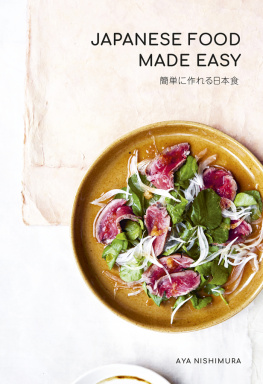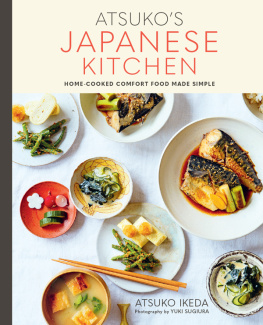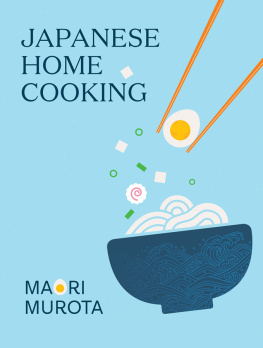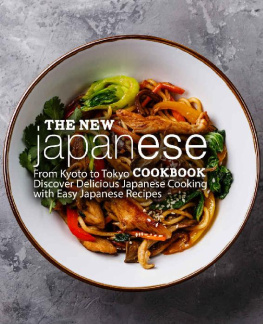Japanese home cooking is simple no need for the difficult techniques or hard-to-find produce sometimes used in restaurants. All you need are the well-selected ingredients and seasonings that elevate a dish to something truly special. Japanese Food Made Easy showcases favourite recipes such as ramen, gyoza, teriyaki and tonkatsu, as well as Japanese dishes generally eaten at home, such as grilled peppers with bonito flakes, kakiage fritters and homemade fried tofu. Youll discover how to make your own teriyaki sauce, tonkatsu sauce, miso dressing and shichimi togarashi (seven chilli mix) these homemade versions are a healthier alternative to store-bought and will bring instant flavour to the simplest dish. There are also recipes for making dashi broth, sushi or sashimi from scratch, for those who want to try making more traditional Japanese food.
Aya Nishimura is a London-based food stylist and recipe writer with over 10 years experience.
Originally from Japan, she comes from a family of chefs and restaurant owners. She developed a passion for food from an early age, but always with a keen eye for the design, publishing and aesthetics of dishes. Since graduating from Leiths School of Food and Wine, Aya has established herself as a popular food stylist working for leading international publishers and titles including Monocle , The Guardian , The Telegraph and Food & Wine magazine. She has developed a strong expertise in a wide variety of culinary methods, but her love of food first grew from her roots in Japanese cuisine. Aya has become known for her simple, elegant styling, applying her unique style across a wide variety of cuisines.
INTRODUCTION Japanese food has the reputation of being hard to make and taking years to master.
INTRODUCTION Japanese food has the reputation of being hard to make and taking years to master.
Although this may be true for some specialist styles of cooking, food that is eaten at home in Japan is very simple and easy to cook and prepare. Furthermore, it is healthy and can be easily introduced into everyday cooking. Most Japanese food can be made very quickly as long as you can get fresh ingredients and a few simple seasonings. The basic seasonings include soy sauce, miso, vinegar, sugar, salt, sake, dashi stock and mirin (Japanese food rarely uses spices). These eight flavours, used in different proportions and combined with fresh ingredients, are the essence of Japanese cooking. This book will introduce you to many popular modern Japanese recipes, such as tonkatsu, ramen and gyoza.
It also showcases Japanese recipes that are generally eaten at home which are very easy to cook but rarely eaten in restaurants dishes like grilled Padrn peppers with bonito flakes, kakiage fritters, homemade fried tofu and sesame tofu. This book will teach you how to use healthy ingredients, such as miso and tofu, in everyday cooking from traditional miso soup and miso-marinated fish to more Western-flavoured tofu and tomato salads, tofu cheesecakes and miso caramel sauce. Learn how to make homemade teriyaki sauce, tonkatsu sauce, miso dressing, shichimi togarashi, furikake sprinkles these useful seasonings can instantly give your cooking a Japanese flavour. They are all free from preservatives and much healthier than the ready-made seasonings from a shop. There are, of course, instructions on how to make dashi stock from scratch or sashimi and sushi for those who would like to try making more traditional Japanese food. Japanese food is simple.
There is no need for difficult techniques or rare ingredients in home cooking. Well-selected ingredients and seasonings, use of texture and subtle attention to detail will lead to surprisingly delicious results, where a simple dish is elevated to something truly special. These are the secrets of Japanese cooking. My heartfelt hope is that this book helps you to discover how simple, delicious and healthy Japanese food can be, and that it becomes part of your daily cooking and weekend gatherings with family and friends.
FOOD MAP OF JAPAN 01: HOKKAIDO This is the second-largest island, with extensive natural resources and it is also famous for its ski resorts. 02: AKITA This is the northern part of the Japanese Honshu mainland, famous for its onsen (hot spring bath). 02: AKITA This is the northern part of the Japanese Honshu mainland, famous for its onsen (hot spring bath).
This area is known for high-quality rice, sake (many renowned sake brewers are from here), kiritanpo nabe (a special type of hotpot) and inaniwa udon noodles. 03: TOKYO This is the capital of Japan and one of the biggest, most cosmopolitan cities in the world. It is the birthplace of nigiri sushi and known for chanko nabe (a hotpot traditionally eaten by sumo wrestlers). 04: SHIZUOKA This city is famous for the Onsen area, which offers hot spring baths. Its well known for its eel cuisine, such as unaju (charcoal-grilled eels on rice) and wild/farmed eel, as well as tea production and fresh wasabi. 05: KYOTO This city used to be the capital of Japan.
It is well known for various types of pickles, such as senmaizuke , shibazuke and suguki , and fresh tofu and other tofu products, such as fried tofu and ganmodoki . Other dishes to note are kappo ryori (a traditional prix-fixe menu/fine dining style where the chef cooks right in front of you), wagashi (traditional Japanese sweets), saba (mackerel) sushi, and the especially famous saikyo miso , which is an extra-sweet white miso. It is also one of the biggest green tea farming districts. 06: OSAKA This is an energetic, friendly city that is famous for its hearty street food. Its well-known dishes include okonomiyaki (savoury pancake) and takoyaki (octopus balls). 07: HYOGO This is a cosmopolitan port city. 07: HYOGO This is a cosmopolitan port city.















